
Video Upload Options
A semaphore telegraph is an early system of conveying information by means of visual signals, using towers with pivoting shutters, also known as blades or paddles. Information is encoded by the position of the mechanical elements; it is read when the shutter is in a fixed position. The most widely used system was invented in 1792 in France by Claude Chappe, and was popular in the late eighteenth to early nineteenth centuries. Lines of relay towers with a semaphore rig at the top were built within line-of-sight of each other, at separations of 5–20 miles (8.0–32.2 km). Operators at each tower would watch the neighboring tower through a spyglass, and when the semaphore arms began to move spelling out a message, they would pass the message on to the next tower. This system was much faster than post riders for conveying a message over long distances, and also had cheaper long-term operating costs, once constructed. Semaphore lines were a precursor of the electrical telegraph, which would replace them half a century later, and would also be cheaper, faster, and more private. The line-of-sight distance between relay stations was limited by geography and weather, and prevented the optical telegraph from crossing wide expanses of water, unless a convenient island could be used for a relay station. Modern derivatives of the semaphore system include flag semaphore (a flag relay system) and the heliograph (optical telegraphy using mirror-directed sunlight reflections).
1. Etymology and Terminology
The word semaphore was coined in 1801 by the French inventor of the semaphore line itself, Claude Chappe.[1] He composed it from the Greek elements σῆμα (sêma, "sign"); and from φορός (phorós, "carrying"),[2] or φορά (phorá, "a carrying") from φέρειν (phérein, "to bear").[3] Chappe also coined the word tachygraph, meaning "fast writer"[4]. However, the French Army preferred to call Chappe's semaphore system the telegraph, meaning "far writer", which was coined by French statesman André François Miot de Mélito.[5] The word semaphoric was first printed in English in 1808: "The newly constructed Semaphoric telegraphs", referring to the destruction of telegraphs in France.[6] The first use of the word semaphore in reference to English use was in 1816: "The improved Semaphore has been erected on the top of the Admiralty", referring to the installation of a simpler telegraph invented by Sir Home Popham. Semaphore telegraphs are also called "optical telegraphs", "shutter telegraph chains", "Chappe telegraphs" or "Napoleonic semaphore".
2. History
2.1. Early Designs
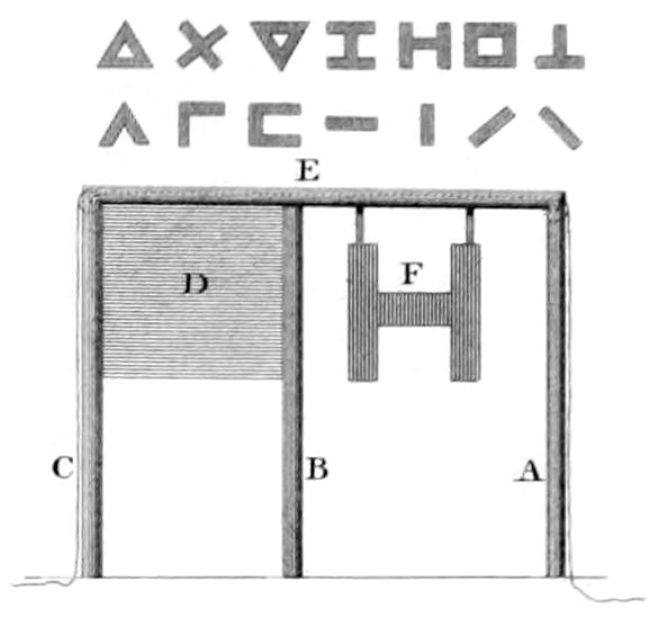
Optical telegraphy dates from ancient times, in the form of hydraulic telegraphs, torches (as used by ancient cultures since the discovery of fire) and smoke signals. Modern design of semaphores was first foreseen by the British polymath Robert Hooke, who gave a vivid and comprehensive outline of visual telegraphy to the Royal Society in a 1684 submission in which he outlined many practical details. The system (which was motivated by military concerns, following the recent Battle of Vienna in 1683) was never put into practice.[7][8]
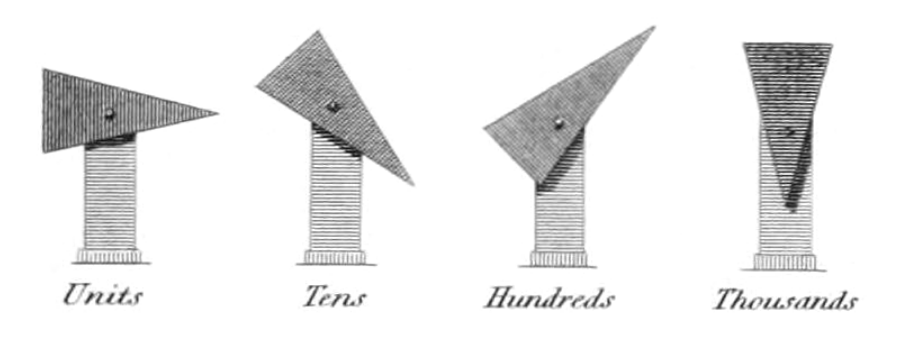
One of the first experiments of optical signalling was carried out by the Anglo-Irish landowner and inventor, Sir Richard Lovell Edgeworth in 1767. The first symbol of a message to Lille would pass through 15 stations in only nine minutes. The speed of the line varied with the weather, but the line to Lille typically transferred 36 symbols, a complete message, in about 32 minutes. Another line of 50 stations was completed in 1798, covering 488 km between Paris and Strasbourg.[9]
Technical operation
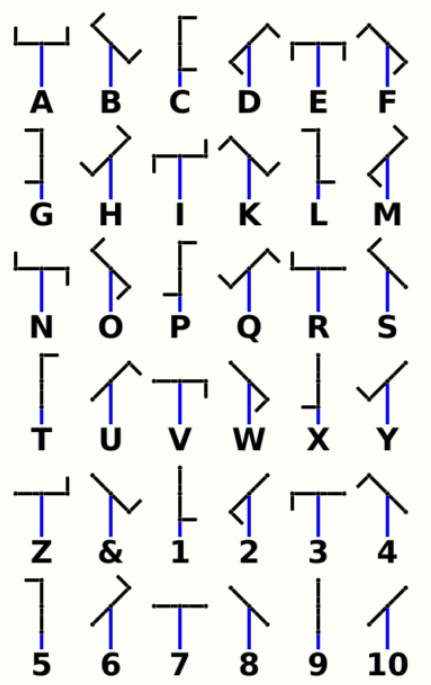
The Chappe brothers determined by experiment that it was easier to see the angle of a rod than to see the presence or absence of a panel. Their semaphore was composed of two black movable wooden arms, connected by a cross bar; the positions of all three of these components together indicated an alphabetic letter. With counterweights (named forks) on the arms, the Chappe system was controlled by only two handles and was mechanically simple and reasonably robust. Each of the two 2-metre-long arms could display seven positions, and the 4.6-metre-long cross bar connecting the two arms could display four different angles, for a total of 196 symbols (7×7×4). Night operation with lamps on the arms was unsuccessful. To speed up transmission and to provide some semblance of security, a code book was developed for use with semaphore lines. The Chappes' corporation used a code that took 92 of the basic symbols two at a time to yield 8,464 coded words and phrases.
The revised Chappe system of 1795 provided not only a set of codes but also an operational protocol intended to maximize line throughput. Symbols were transmitted in cycles of "2 steps and 3 movements."
- Step 1, movement 1 (setup): The indicator arms were turned to align with the cross bar, forming a non-symbol. The crossbar was then moved into position for the current symbol.
- Step 1, movement 2 (transmission): The indicator arms were positioned for the current symbol. The operator then waited for the downline station to copy it.
- Step 2, movement 3 (completion): The cross bar was turned to a vertical or horizontal position, indicating the end of a cycle.
In this manner, each symbol could propagate down the line as quickly as operators could successfully copy it, with acknowledgement and flow control built into the protocol. A rate of 2-3 symbols per minute was typical.[10][11]
2.2. Other Systems
From 1803 on, the French also used the 3-arm Depillon semaphore at coastal locations to provide warning of British incursions.[12] Many national services adopted signaling systems different from the Chappe system. For example, the UK and Sweden adopted systems of shuttered panels (in contradiction to the Chappe brothers' contention that angled rods are more visible). In Spain, the engineer Agustín de Betancourt developed his own system which was adopted by that state. This system was considered by many experts in Europe better than Chappe's, even in France. In Ireland R.L. Edgeworth was to develop an optical telegraph based on a triangle pointer, measuring up to 16 feet in height. Following a number of years promoting his system, he was to get admiralty approval and engaged in its construction during 1803-4. The completed system ran from Dublin to Galway and was act as a rapid warning system in case of French invasion of the west coast of Ireland. Despite its success in operation, the receding threat of French invasion was to see the system disestablished in 1804.[13]
3. Use in Various Countries
3.1. France
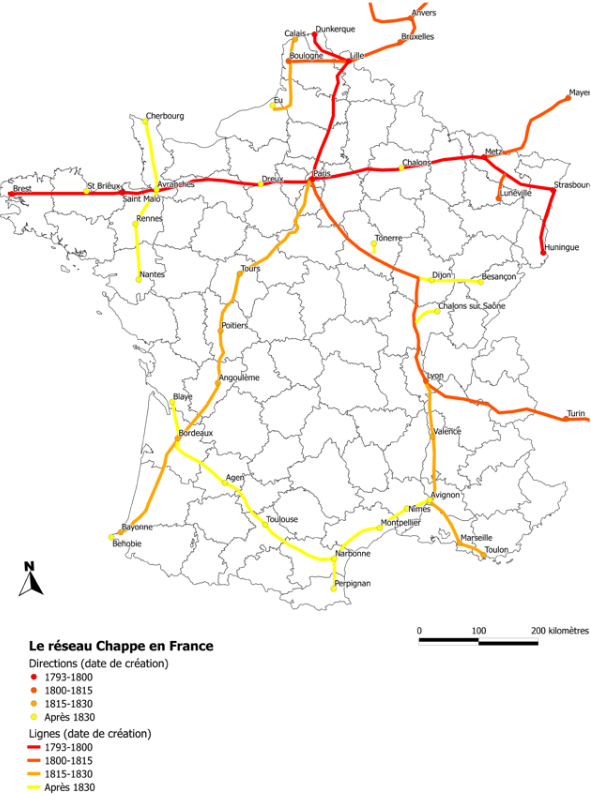
After Chappe's initial line (between Paris and Lille), the Paris to Strasbourg with 50 stations followed soon after (1798). By 1824, the Chappe brothers were promoting the semaphore lines for commercial use, especially to transmit the costs of commodities. Napoleon Bonaparte saw the military advantage in being able to transmit information between locations, and carried a portable semaphore with his headquarters. This allowed him to coordinate forces and logistics over longer distances than any other army of his time. However, because stations had to be within sight of each other, and because the efficient operation of the network required well trained and disciplined operators, the costs of administration and wages were a continuous source of financial difficulties. Only when the system was funded by the proceeds of its own lottery did costs come under control.[clarification needed]
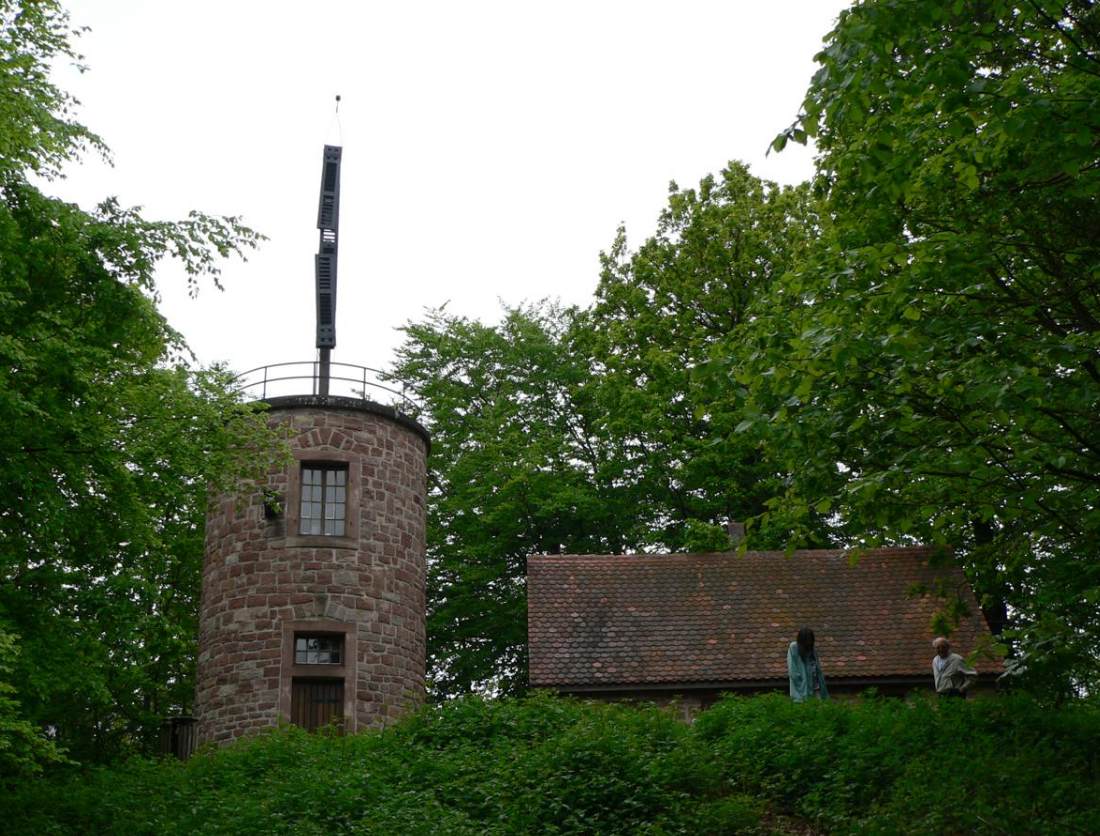
In 1821 Norwich Duff, a young British Naval officer, visiting Clermont-en-Argonne, walked up to the telegraph station there and engaged the signalman in conversation. Here is his note of the man's information:
The pay is twenty five sous per day and he [the signalman] is obliged to be there from day light till dark, at present from half past three till half past eight; there are only two of them and for every minute a signal is left without being answered they pay five sous: this is a part of the branch which communicates with Strasburg and a message arrives there from Paris in six minutes it is here in four.
The network was reserved for government use but in 1834 two bankers, François and Joseph Blanc, devised a way to subvert it to their own ends.[14]
3.2. Sweden
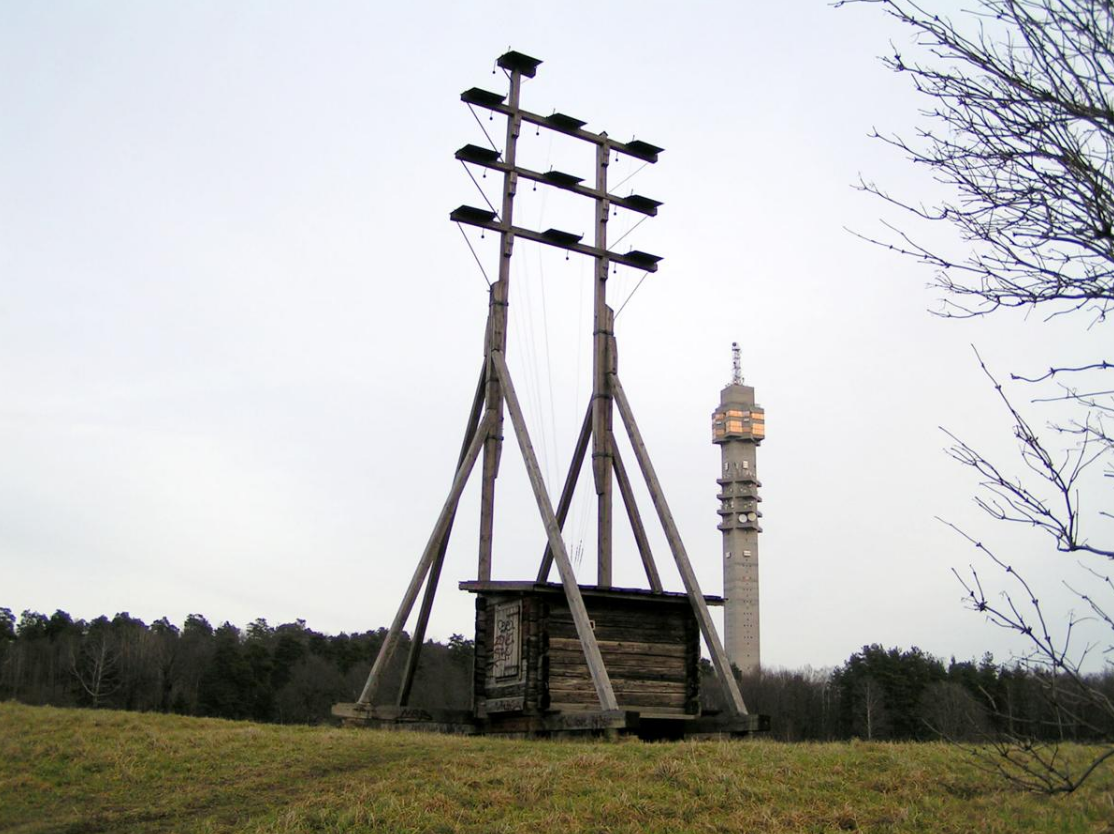
At the same time as Chappe, the Swedish inventor Abraham Niclas Edelcrantz experimented with the optical telegraph in Sweden. In 1794 he inaugurated his telegraph with a poem dedicated to the Swedish King on his birthday. The message went from the Palace in Stockholm to the King at Drottningholm. Edelcrantz eventually developed his own system which was quite different from its French counterpart and nearly twice as fast. The system was based on ten collapsible iron shutters. The various positions of the shutters formed combinations of numbers which were translated into letters, words or phrases via codebooks. The telegraph network consisted of telegraph stations positioned at about 10 kilometres (6.2 mi) from one another.
3.3. United Kingdom

In Ireland, Richard Lovell Edgeworth returned to his earlier work in 1794, and proposed a telegraph there to warn against an anticipated French invasion; however, the proposal was not implemented. Lord George Murray, stimulated by reports of the Chappe semaphore, proposed a system of visual telegraphy to the British Admiralty in 1795.[15] He employed rectangular framework towers with six, five feet high octagonal shutters on horizontal axes that flipped between horizontal and vertical positions to signal. [16] The Rev. Mr Gamble also proposed two distinct five-element systems in 1795: one using five shutters, and one using five ten foot poles.[15] The British Admiralty accepted Murray's system in September 1795, and the first system was the 15 site chain from London to Deal.[17] Messages passed from London to Deal in about sixty seconds, and sixty-five sites were in use by 1808.[17]
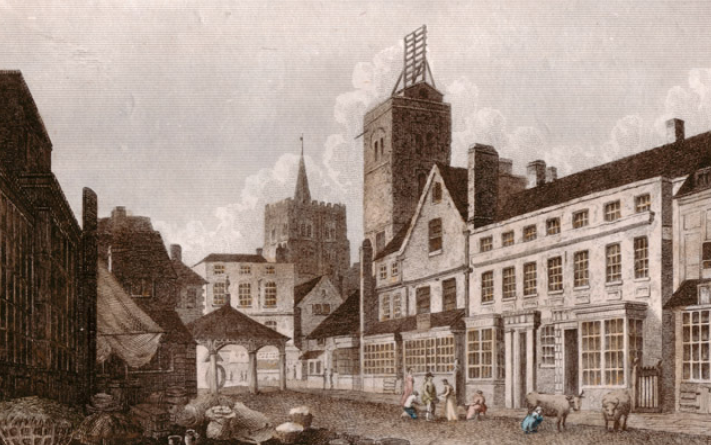
Chains of Murray's shutter telegraph stations were built along the following routes: London—Deal and Sheerness, London—Great Yarmouth and London—Portsmouth and Plymouth. The shutter stations were temporary wooden huts, and at the conclusion of the Napoleonic wars they were no longer necessary, and were closed down by the Admiralty in March 1816.[18]
Following the Battle of Trafalgar, the news was transmitted to London by frigate to Falmouth, from where the captain brought the dispatches to London by coach along what became known as the Trafalgar Way; the journey took 38 hours. This delay prompted the Admiralty to investigate further.
A replacement semaphore system was sought, and of the many ideas and devices put forward the Admiralty chose the simpler semaphore system invented by Sir Home Popham.[15][19] A Popham semaphore was a single fixed vertical 30 foot pole, with two movable 8 foot arms attached to the pole by horizontal pivots at their ends, one arm at the top of the pole, and the other arm at the middle of the pole.[12][19] The signals of the Popham semaphore were found to be much more visible than those of the Murray semaphore.[12] Popham's 2-arm semaphore was modeled after the 3-arm Depillon French semaphore.[12] An experimental semaphore line between the Admiralty and Chatham was installed in July 1816, and its success helped to confirm the choice.[18]
Subsequently, the Admiralty decided to establish a permanent link to Portsmouth and built a chain of semaphore stations. Work started in December 1820[18] and the line was operational from 1822 until 1847, when the railway and electric telegraph provided a better means of communication. The semaphore line did not use the same locations as the shutter chain, but followed almost the same route with 15 stations - Admiralty (London), Chelsea Royal Hospital, Putney Heath, Coombe Warren, Coopers Hill, Chatley Heath, Pewley Hill, Bannicle Hill, Haste Hill (Haslemere), Holder Hill, (Midhurst), Beacon Hill, Compton Down, Camp Down, Lumps Fort (Southsea), and Portsmouth Dockyard. The semaphore tower at Chatley Heath, which replaced the Netley Heath station of the shutter telegraph, has been restored by Surrey County Council and is open to the public.
A chain of stations was established from London to Plymouth, and in good conditions messages were delivered end-to-end in only eight minutes.[20]
The Board of Port of Liverpool obtained a Private Act of Parliament to construct a chain of Popham optical semaphore stations from Liverpool—Holyhead in 1825.[21] Many of the prominences on which the towers were built ('telegraph hills') are known as Telegraph Hill to this day. As in France the network required lavish amounts of money and manpower to operate and could only be justified as a defence need.
3.4. Other Countries
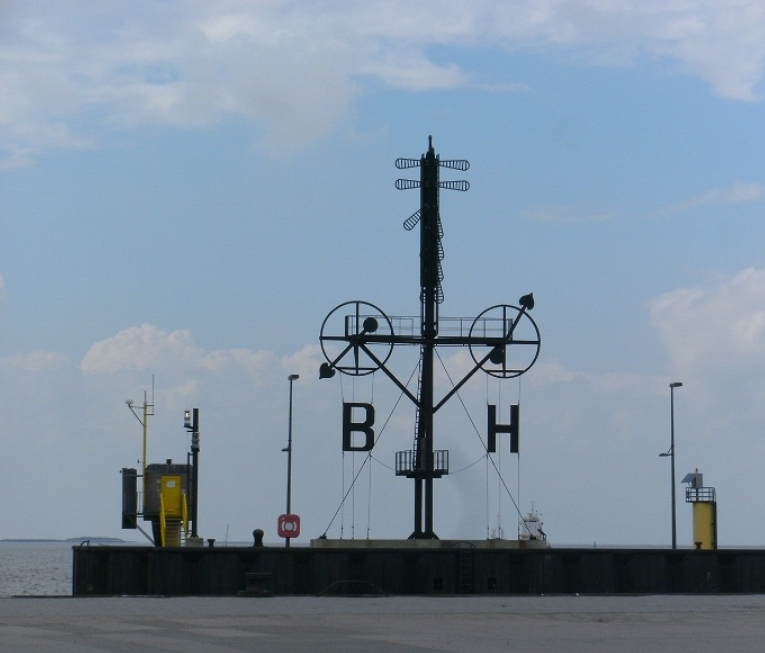
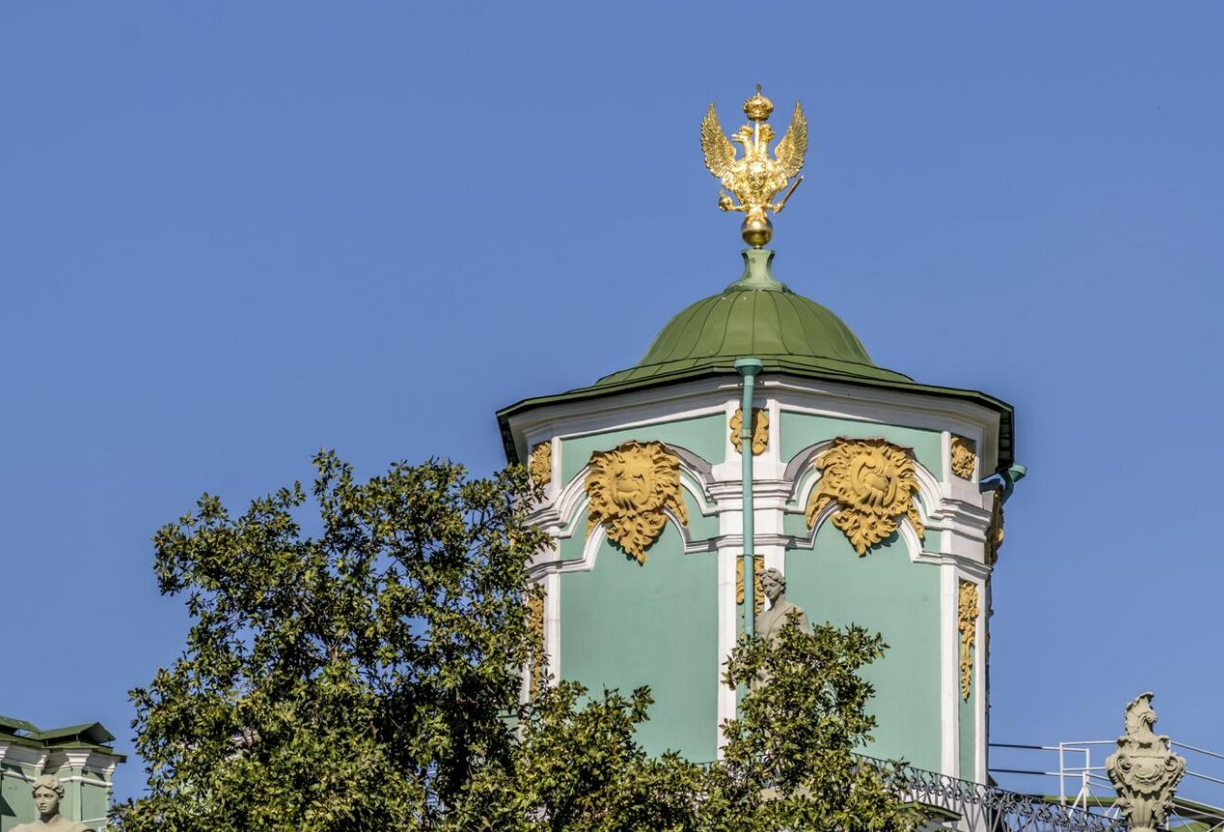
Once it had proved its success, the optical telegraph was imitated in many other countries, especially after it was used by Napoleon to coordinate his empire and army. In most of these countries, the postal authorities operated the semaphore lines.
In Portugal, the British forces fighting Napoleon in Portugal soon found that the Portuguese Army had already a very capable semaphore terrestrial system working since 1806, giving the Duke of Wellington a decisive advantage in intelligence. The innovative Portuguese telegraphs, designed by Francisco Ciera, a mathematician, were of 3 types: 3 shutters, 3 balls and 1 pointer/moveable arm (the first for longer distances, the other two for short) and with the advantage of all having only 6 significant positions. He also wrote the code book "Táboas Telegráphicas", with 1554 entries from 1 to 6666 (1 to 6, 11 to 16,... 61 to 66, 111 to 116,... etc.), the same for the 3 systems. Since early 1810 the network was operated by "Corpo Telegráfico", the first Portuguese military Signal Corps.
Spain was spanned by an extensive semaphore telegraph network in the 1840s and 1850s[22]. The three main semaphore lines radiated from Madrid[22][23]. The first ran north to Irun on the Atlantic coast at the French border. The second ran west to the Mediterranean, then north along the coast through Barcelona to the French border. The third ran south to Cadiz on the Atlantic coast. These lines served many other Spanish cities, including: Aranjuez, Badajoz, Burgos, Castellon, Ciudad Real, Córdoba, Cuenca, Gerona, Pamplona, San Sebastian, Seville, Tarancon, Taragona, Toledo, Valladolid, Valencia, Vitoria and Zaragoza.[23]
In Canada, Prince Edward, Duke of Kent established the first semaphore line in North America. In operation by 1800, it ran between the city of Halifax and the town of Annapolis in Nova Scotia, and across the Bay of Fundy to Saint John and Fredericton in New Brunswick. In addition to providing information on approaching ships, the Duke used the system to relay military commands, especially as they related to troop discipline. The Duke had envisioned the line reaching as far as the British garrison at Quebec City; however, the many hills and coastal fog meant the towers needed to be placed relatively close together to ensure visibility. The required labour to build and continually man so many stations taxed the already stretched-thin British military and there is doubt the New Brunswick line was ever in operation. With the exception of the towers around Halifax harbour, the system was abandoned shortly after the Duke's departure in August 1800.[24][25]

In 1801, the Danish post office installed a semaphore line across the Great Belt strait, Storebæltstelegrafen, between islands Funen and Zealand with stations at Nyborg on Funen, on the small island Sprogø in the middle of the strait, and at Korsør on Zealand. It was in use until 1865.[26]
The Kingdom of Prussia began with a line 750 kilometres (470 mi) long between Berlin and Coblenz in 1833, and in Russia, Tsar Nicolas I inaugurated a line between Moscow and Warsaw of 1,200 kilometres (750 mi) length in 1833; it needed 220 stations manned by 1,320 operators.
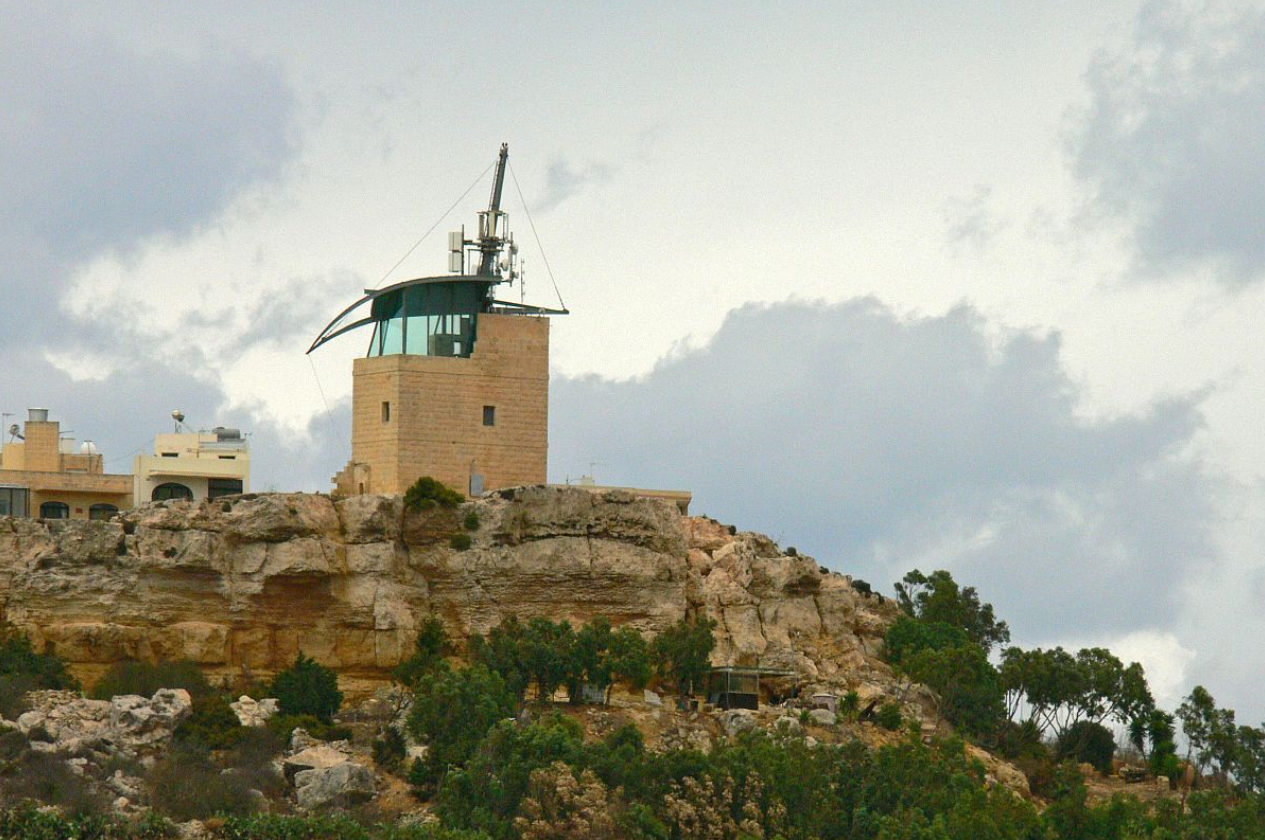
The British military authorities began to consider installing a semaphore line in Malta in the early 1840s. Initially, it was planned that semaphore stations be established on the bell towers and domes of the island's churches, but the religious authorities rejected the proposal. Due to this, in 1848 new semaphore towers were constructed at Għargħur and Għaxaq on the main island, and another was built at Ta' Kenuna on Gozo. Further stations were established at the Governor's Palace, Selmun Palace and the Giordan Lighthouse. Each station was manned by the Royal Engineers.[27]
In the United States, the first optical telegraph was built by Jonathan Grout in 1804 but ceased operation in 1807. This 104-kilometre (65 mi) line between Martha's Vineyard with Boston transmitted shipping news. An optical telegraph system linking Philadelphia and the mouth of the Delaware Bay was in place by 1809 and had a similar purpose; a second line to New York City was operational by 1834, when its Philadelphia terminus was moved to the tower of the Merchants Exchange. One of the principal hills in San Francisco, California is also named "Telegraph Hill", after the semaphore telegraph which was established there in 1849 to signal the arrival of ships into San Francisco Bay.
The semaphores were successful enough that Samuel Morse failed to sell the electrical telegraph to the French government; however, France finally committed to replace semaphores with electric telegraphs in 1846. Electric telegraphs are both more private and almost completely unaffected by weather; they also work at night. Many contemporaries predicted the failure of electric telegraphs because "they are so easy to cut."[28]
In India, semaphore towers were introduced in 1810. A series of towers were built between Fort William, Kolkata to Chunar Fort near Varanasi.The towers in the plains were 75 - 80 feet tall and those in the hills were 40 - 50 feet tall, and were built at an interval of about 13 km.[29] The last stationary semaphore link in regular service was in Sweden, connecting an island with a mainland telegraph line. It went out of service in 1880.
4. In Popular Culture
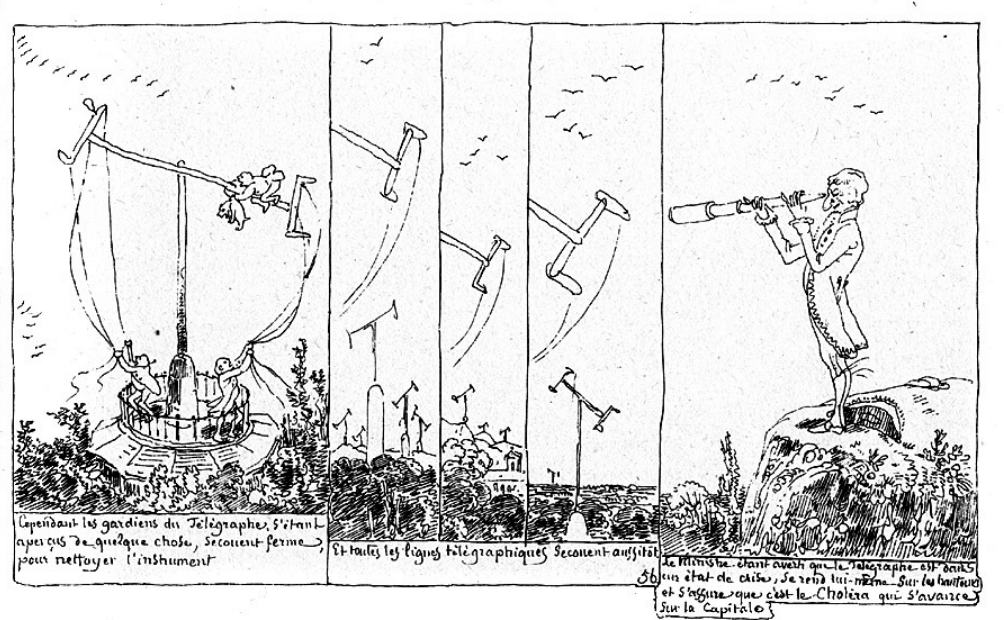
By the mid 19th century, the optical telegraph was well-known enough to be referenced in popular works without special explanation. The Chappe telegraph appeared in contemporary fiction and comic strips. In "Mister Pencil" (1831), comic strip by Rodolphe Töpffer, a dog fallen on a Chappe telegraph's arm and its master attempting to help provoke an international crisis by involuntarily transmitting disturbing messages. In "Lucien Leuwen" (1834), Stendhal pictures a power struggle between Lucien Leuwen and the prefect M. de Séranville with the telegraph's director M. Lamorte. In Chapter 60 ("The Telegraph") of Alexandre Dumas' The Count of Monte Cristo (1844), the title character describes with fascination the semaphore line's moving arms. "I had at times seen rise at the end of a road, on a hillock and in the bright light of the sun, these black folding arms looking like the legs of an immense beetle."[30] He later bribes a semaphore operator to relay a false message in order to manipulate the French financial market. Dumas also describes in details the functioning of a Chappe telegraph line. In Hector Malot's novel Romain Kalbris (1869), one of the characters, a girl named Dielette, describes her home in Paris as "...next to a church near which there was a clock tower. On top of the tower there were two large black arms, moving all day this way and that. [I was told later] that this was Saint-Eustache church and that these large black arms were a telegraph."[31]
References
- Groundbreaking Scientific Experiments, Inventions & Discoveries of the 18th Century, Jonathan Shectman, p. 172
- Oxford English Dictionary.
- Webster's Unabridged Dictionary.
- Beyer, Rick, The Greatest Stories Never Told, A&E Television Networks / The History Channel, ISBN:0-06-001401-6, p. 60
- Le Robert historique de la langue française, 1992, 1998
- 500 Years of New Words, Bill Sherk
- "The Origin of the Railway Semaphore". Mysite.du.edu. http://mysite.du.edu/~jcalvert/railway/semaphor/semhist.htm. Retrieved 2013-06-17.
- "History of the Telephone part2". Ilt.columbia.edu. http://www.ilt.columbia.edu/projects/bluetelephone/html/part2.html. Retrieved 2013-06-17.
- http://www.ieeeghn.org/wiki/images/1/17/Dilhac.pdf
- Holzmann, Gerard J.; Pehrson, Bjorn (2003). The Early History of Data Networks.
- https://web.archive.org/web/20140202183712/http://chappe.ec-lyon.fr/message.html
- Chapter 2: Semaphore Signalling ISBN:978-0-86341-327-8 Communications: an international history of the formative years R. W. Burns, 2004 https://books.google.com/books?id=7eUUy8-VvwoC&pg=PA29
- Adrian James Kirwan, 'R.L. Edgeworth and Optical Telegraphy in Ireland, c. 1790-1805' in Proceedings of the Royal Irish Academy (2017). https://www.jstor.org/stable/10.3318/priac.2017.117.02?seq=1#page_scan_tab_contents
- https://www.inc.com/magazine/19990915/13554.html
- Telegraph, Volume 17 of The Edinburgh Encyclopaedia, pp. 664–667, 1832 David Brewster, ed. https://books.google.com/books?id=VhEbAQAAMAAJ&pg=PA657
- Lieutenant Watson's Telegraph Mechanics' magazine, Volume 8 No. 222, Knight and Lacey, 1828, pages 294-299 https://books.google.com/books?id=rNZQAAAAYAAJ&pg=PA298
- F.B. Wrixon (2005), ISBN:978-1-57912-485-4 Codes, Ciphers, Secrets and Cryptic Communication pp. 444-445 cover Murray's shutter telegraph in the U.K., with codes.
- Military Signals from the South Coast, John Goodwin, 2000
- Telegraph Vol 10, Encyclopædia Britannica, 6th Edition, 1824 pp. 645–651 https://books.google.com/books?id=MsYnAAAAMAAJ&pg=PA645
- C. I. Hamilton, The Making of the Modern Admiralty: British Naval Policy-Making, 1805–1927, p. 92, Cambridge University Press, 2011 ISBN:9781139496544.
- Faster Than The Wind, The Liverpool to Holyhead Telegraph, Frank Large, an avid publication ISBN:0-9521020-9-9
- Roig, Sebastián Olivé (1990). Historia de la telegrafía óptica en España. Madrid: MINISTERIO DE TRANSPORTE, TURISMO Y COMUNICACIONES. http://forohistorico.coit.es/index.php/biblioteca/libros-electronicos/item/historia-de-la-telegrafia-optica-en-espana. Retrieved 10 January 2019.
- Fundación Telefónica (2014). Telégrafos. Un relato de su travesía centenaria. Grupo Planeta Spain. ISBN 8408129651. https://books.google.com/books?newbks=1&id=ANkcAwAAQBAJ&pg=PA1843. Retrieved 10 January 2019.
- Raddall, Thomas H. (1971), Warden of the North, Toronto, Canada: McClelland and Stewart Limited, http://www.ourroots.ca/toc.aspx?id=6183&qryID=8cbb8294-7361-4fdc-ac50-78627a229b5f
- Rens, Jean-Guy (2001), The invisible empire: A history of the telecommunications industry in Canada, Montreal, Canada: McGill-Queen's University Press, https://books.google.ca/books?id=8kUmt-Q7ySMC&pg=PA7&lpg=PA7&dq=nova+scotia+semaphore+line#v=onepage&q=nova%20scotia%20semaphore%20line&f=false
- The Age of Invention 1849–1920, Post & Tele Museum Danmark, website visited on May 8, 2010. http://www.ptt-museum.dk/en/exhibitions/the_permanent_exhibition/the_age_of_invention/
- "Semaphore Tower". Archived from the original on 4 March 2016. https://web.archive.org/web/20160304094408/http://gharghur.gov.mt/semaphore-tower/.
- Holzmann, Gerard. "Data Communications: The First 2,500 Years". http://spinroot.com/gerard/pdf/hamburg94b.pdf. Retrieved 28 June 2011.
- Singh, Gurvinder (18 May 2018). "Towering messengers of a bygone era". https://www.thehindubusinessline.com/blink/know/towering-messengers-of-a-bygone-era/article23923909.ece. Retrieved 31 March 2019.
- Page 84 in http://www.ebooksgratuits.com/pdf/dumas_monte_cristo_3.pdf
- See second paragraph in http://www.inlibroveritas.net/lire/oeuvre23495.html#page_163




